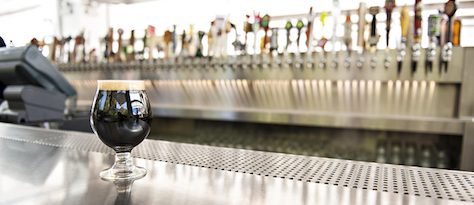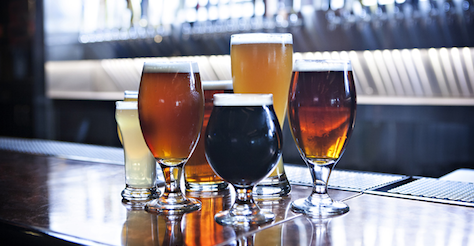
Craft Beer is booming. Recent reports show that over the last four years, the market share of craft beer has increased from 4.4% to 7.8% of the total beer industry. In addition, in 2013 the overall U.S. beer market saw a decline of 1.9%, yet craft beer brewers saw sales increase by 18%, leading Bloomberg to state, “Goose Island is the new Bud. So are Shock Top and ZiegenBock. And Leinenkugel’s and Blue Moon, for that matter, could be called the new Coors or Miller.”
Of course, craft beer goes much deeper than those brands, which are in fact owned by some of the larger beverage companies. From Oregon to Texas to Michigan, everyone has a new local brewery focusing on intense, unique flavors and one-off releases. With all this noise around, we thought we would get back to some basics, and share an Introduction to Craft Beer.
What is Craft Beer?
Craft Beer is a ‘not always consistent’ term that usually means relatively small, independently-produced batches of beer. How small? Well, there’s your inconsistency. Sometimes small enough to be rare or sought after, and sometimes large enough to be in national grocery store chains and TV commercials.
Another way to slice it: generally, craft beer comes from Craft Breweries. The Brewers Association (the not-for-profit trade association that represents the majority of U.S. breweries) classifies craft breweries as:
Small: Annual production of 6 million barrels of beer or less (approximately 3 percent of U.S. annual sales). Beer production is attributed to a brewer according to the rules of alternating proprietorships.*
Independent: Less than 25% of the craft brewery is owned or controlled (or equivalent economic interest) by an alcoholic beverage industry member who is not themselves a craft brewer.
Traditional: A brewer that has a majority of its total beverage alcohol volume in beers whose flavor derives from traditional or innovative brewing ingredients and their fermentation. A brewer who has either an all malt flagship (the beer which represents the greatest volume among that brewers brands) or has at least 50% of its volume in either all malt beers or in beers which use adjuncts to enhance rather than lighten flavor.*
*Flavored malt beverages (FMBs) are not considered beers for purposes of this definition.
By this definition, 98% of the 2,822 breweries in the U.S. are craft breweries.

Why has Craft Beer Boomed?
The movement is closely linked to a food and drink education revolution, where knowledge and community are the key ingredients. Understanding what goes into your food and drink, knowing from where it came, how it was made, who it was made by, and why they used the particulars and style they did, is not uncommon for wine lovers, cheese lovers, bread lovers and more. Local producers, local chefs, local foodies and local food bloggers are all helping each other sustain, and helping create a passion for the artisan that hasn’t been seen on this scale before.
The same applies to craft beer.
Craft Beer has boomed because people truly care about their beer, whether making it or drinking it. Craft brewers are passionates, fanatics, teachers, geeks, and … The way that a craft beer is developed, from conception to presentation, is a labor of love.
There is also the current trend of buying local, which fuels beer choices. Buying and drinking local beer keeps your local brewery alive and local people employed, and in theory you will pay local prices for the freshest beer, having less shipping costs and time in transportation to allow for.

 In effect, beer is diversifying to reach small, unique markets, and it is the combination of these thousands of niche markets that leads to the growth of ‘craft beer’ as a whole.
In effect, beer is diversifying to reach small, unique markets, and it is the combination of these thousands of niche markets that leads to the growth of ‘craft beer’ as a whole.
When did the Craft Beer Boom Begin?
At any given Beer Festival, Beer Tapping event, or online beer forum, you will likely meet someone who has been drinking, reviewing, and home-brewing small batch beers for decades. Indeed; ‘craft beer’, independent breweries, and beer nerds have all been around since the beginning of beer-time.
The 1970s-1990s saw the beer industry, much like the media, music and movie industries, consolidate into global corporate giants. Despite this, the spirit, culture, and knowledge survived, and there was a small population that used the term ‘microbrewing’. Microbrews, from Microbreweries, started to become more common towards the end of the century, and the scene somehow morphed into our current ‘craft brewing’ industry.
However, the real boom that we are currently seeing, resulting in the macros making their buy-outs and adapting marketing strategies, has been bubbling away for about 5-10 years: since 2003 we have seen consistent increases in both the number of craft brewers overall, and the market segment that they reach.
This ‘new wave’ of educated beer communities has brought us to the current pinnacle, where some mainstream media and commercial retail outlets are often just as brew-savvy as many regular drinkers.

How Much Has Craft Beer… umm… ‘Boomed’?
The latest 2013 statistics have just been released by the Brewers Association. In short: craft brewers saw an 18% increase in volume to 15.6 million barrels, and now occupy 7.8 percent of the total U.S. beer market by volume. In addition, they saw retail dollar value increase 20% to reach $14.3 billion dollars. The 2013 data is not unusual:

 2012 saw increases of 15% in volume and 17% in dollars. 2011 saw 13% and 15% rises respectively. These double digit increases have been happening for the best part of a decade.
2012 saw increases of 15% in volume and 17% in dollars. 2011 saw 13% and 15% rises respectively. These double digit increases have been happening for the best part of a decade.
Will the Rise of Craft Beer Stop Anytime Soon?
See also: ‘Is the Craft Beer Movement a Bubble About to Burst?’
In our opinion… no.
The U.S. loves beer. That will likely never change, and recent years even saw sales of beer surpass sales of wine and liquor combined. The fact that Craft Beer has made the most significant increases in recent years and yet still occupies a small segment of the total beer market means that there is still lots of room to grow. Will every brewery that has established itself in the last 10 years survive over the next 10? Not all, but the good ones will, and they will grow stronger as the community as a whole continues to support and invest in itself.
The Craft Beer scene is largely void of non-beer-loving investors who’s sole aim is to make money and essentially exploit craft brewers and fans of craft beer. This protective barrier will also help protect any ‘bubble’ and ‘bursting’ effect.
Craft Beer is here to stay, and will continue to thrive. The only thing we need to worry about is… “Which beer do I drink next?”
Sign up for email updates from the Bottleneck Blog at the top of the page, for more Craft Beer news, stories, tips and advice.
by Bottleneck Management.
